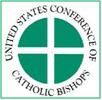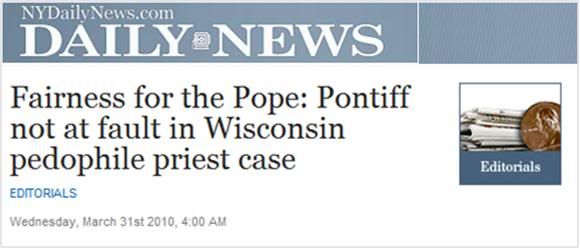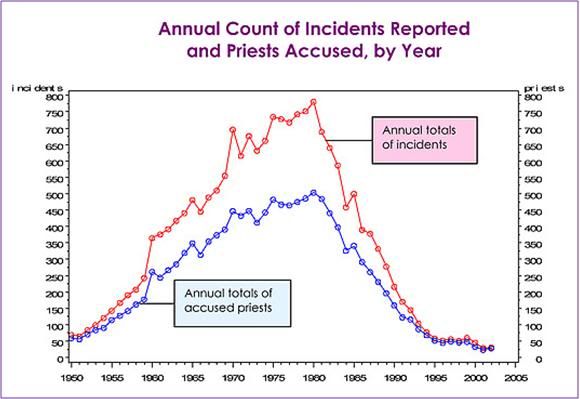
 U.S. Bishops voice concern for victims
U.S. Bishops voice concern for victims
victims of clergy sexual abuse and
thank the Pope for his Leadership

WASHINGTON, March 31 - The U.S. bishops March 30 voiced concern for victims of child sexual abuse by clerics and praised Pope Benedict XVI for leadership in dealing with the sin and crime of child sexual abuse.
“We know from our experience how Pope Benedict is deeply concerned for those who have been harmed by sexual abuse and how he has strengthened the Church’s response to victims and supported our efforts to deal with perpetrators,” the bishops said. “We continue to intensify our efforts to provide safe environments for children in our parishes and schools. Further, we work with others in our communities to address the prevalence of sexual abuse in the larger society.”
The bishops’ comments came in a statement issued by the Executive Committee of the United States Conference of Catholic Bishops: Cardinal Francis George, OMI, of Chicago, president; Bishop Gerald Kicanas of Tucson, Arizona, vice-president; Archbishop Joseph Kurtz of Louisville, treasurer; Bishop George Murry, SJ of Youngstown, Ohio, secretary; and Bishop Arthur Serratelli of Paterson, New Jersey, elected member.
The complete statement follows.
 On behalf of the Catholic bishops of the United States, we, the members of the Executive Committee of the United States Conference of Catholic Bishops, write both to express our deep concern for those harmed by the crime and sin of sexual abuse by clergy and to express our profound gratitude for the assistance that Pope Benedict XVI has given us in our efforts to respond to victims, deal with perpetrators and to create safe environments for children.
On behalf of the Catholic bishops of the United States, we, the members of the Executive Committee of the United States Conference of Catholic Bishops, write both to express our deep concern for those harmed by the crime and sin of sexual abuse by clergy and to express our profound gratitude for the assistance that Pope Benedict XVI has given us in our efforts to respond to victims, deal with perpetrators and to create safe environments for children.
The recent emergence of more reports of sexual abuse by clergy saddens and angers the Church and causes us shame. If there is anywhere that children should be safe, it should be in their homes and in the Church.
We know from our experience how Pope Benedict is deeply concerned for those who have been harmed by sexual abuse and how he has strengthened the Church’s response to victims and supported our efforts to deal with perpetrators.
We continue to intensify our efforts to provide safe environments for children in our parishes and schools. Further, we work with others in our communities to address the prevalence of sexual abuse in the larger society.
One of the most touching moments of the Holy Father’s visit to the United States in 2008 was his private conversation with victims/survivors at the Apostolic Nunciature in Washington.
Pope Benedict heard firsthand how sexual abuse has devastated lives. The Holy Father spoke with each person and provided every one time to speak freely to him. They shared their painful experiences and he listened, often clasping their hands and responding tenderly and reassuringly.
With the support of both Pope John Paul II and Pope Benedict XVI, we bishops have made a vigorous commitment to do everything in our power to prevent abuse from happening to children.
We live out this commitment through the Charter for the Protection of Children and Young People, which calls us to respond with compassion to victims/survivors, to work diligently to screen those working with children and young people in the Church, to provide child abuse awareness and prevention education, to report suspected abuse to civil law enforcement, and to account for our efforts to protect children and youth through an external annual national audit.
As we accompany Christ in His passion and death during this Holy Week, we stand with our Holy Father Pope Benedict XVI in prayer for the victims of sexual abuse, for the entire Church and for the world.
Cardinal Francis George, OMI
Archbishop of Chicago
President
Bishop Gerald Kicanas
Bishop of Tucson
Vice-President
Bishop George Murry, SJ
Bishop of Youngstown
Secretary
Archbishop Joseph Kurtz
Archbishop of Louisville
Treasurer
Bishop Arthur Serratelli
Bishop of Paterson
Elected Member
NB: Since my original post this morning on Archbishop Nichols In London and Archbishop Listecki in Milwaukee, I have since added similar statements of individual support by Bishop De Marzio of Brooklyn and Cardinal Mahony of LA to the post.
BTW, I am mystified why it took so long for the US bishops to come out with this statement! And yet, it ostentatiously makes no reference at all to the media campaign of disinformation now driven, fueled and pumped up primarily by the US media!
PPS#2 -
The New York Times has now posted an article based on Cardinal Levada's statement - and I have added it to my original post above on the cardinal's statement.... Of course, we do not know if the article will appear in the print edition of the newspaper at all, and if so, on what page???
 'Fairness for the Pope':
'Fairness for the Pope':
Editorial in a New York paper!
Now, this one really surprised me! I hardly look at the Daily News because it's too liberal for my taste, but I take my hat off to them today for being probably the first and only MSM newspaper in the United States - or anywhere else, for that matter - to come out with an editorial in support of the Pope, even if it has to do only with the Murphy case:

It has become an increasingly prevailing belief that as a cardinal, before he ascended to the papacy, Pope Benedict enabled a pedophile priest to do enormous harm. This is false.
New York Times columnist Maureen Dowd took the accusations against the Pope, whose given name is Joseph Ratzinger, to their most extreme. She wrote:
"Now we learn the sickening news that Cardinal Joseph Ratzinger, nicknamed 'God's Rottweiler' when he was the church's enforcer on matters of faith and sin, ignored repeated warnings and looked away in the case of the Rev. Lawrence C. Murphy, a Wisconsin priest who molested as many as 200 deaf boys."
Again, and with certainty: This is false.
There is much to criticize in the Catholic Church's abysmal failure for decades to take action against priests who engaged in sexual abuse. That history tends to lend credence to reports that the hierarchy has either turned a blind eye or engaged in coverups.
Maybe even the Pope.
While the Murphy case does exemplify the Church at its worst, the grievous sins in this matter cannot be laid to Pope Benedict.
For 24 years starting in 1950, Murphy served as a priest at a school for deaf boys in Milwaukee. He was first accused of molesting students in the 1950s, and he was trailed by similar accounts until the church forced him onto "temporary sick leave." His superiors did not report Murphy to the police or take further internal action.
Those crimes, dating back half a century, took place decades before Ratzinger rose to high church positions in Europe. He could not have ignored repeated warnings, nor could he have looked away. He was not on the scene at all.
Murphy next surfaces in 1996, 22 years after his last reported offense. Amid the scandals that swamped the church, some of Murphy's victims pressed the archbishop of Milwaukee to take action. He wrote to Ratzinger, who had by then risen to head the Vatican's Congregation for the Defense of the Faith.
The letter, one of only two in the files bearing Ratzinger's name, asked for advice on how to proceed. Ratzinger did not respond. The archbishop brought charges nonetheless.
Ratzinger's deputy then approved bringing charges that could lead to defrocking Murphy. And the Vatican kept the case alive by waiving its own internal statute of limitations on pressing cases against priests.
In June, 1998, Murphy wrote to Ratzinger, citing the fact that he had suffered strokes and asking to live out his days. Ratzinger's deputy suggested letting Murphy accept banishment, a step short of full defrocking, if he admitted guilt and expressed remorse. The Wisconsin bishop who had taken the case refused.
In August 1998, two weeks before Murphy's impending death, the archbishop of Milwaukee reported to Rome that he had suspended the trial and would try to get letters of apology from Murphy. The suspension order was never conveyed to the priest that headed the trial panel. He says he would have fought such a command and that Murphy died while charges were still pending.
What exactly did then-Cardinal Ratzinger do wrong? His office approved the trial and waived the statue of limitations. Those are not the makings of a coverup.
At the same time, it's fair game to debate whether his office should have considered for a moment a plea deal, even on the verge of Murphy's death. But that's a far cry from vilifying Benedict as a man who took no action in the face of Murphy's evil or many years later tried to paper it over.
This editorial can be appreciated so much more because the Daily News is published by a prominent Jewish liberal, Mort Zuckerman, who has occasionally written articles himself in other magazines and newspapers. Thank you, Mr. Zuckerman and the Daily News!
Perhaps NYT's in-house Catholic Op-Ed columnist Ross Douthat was 'prudent' not to write anything that would lose him his gig (that he has held at the Times since April 2009). if it gives him the chance to have useful information published in the Times that would otherwise never come out in their pages. This was a two-part article from yesterday and today, which I am posting here because it is germane to the issue, but which I will also post in REFERENCES later...
The pattern of priestly sex abuse


March 30-31, 2010
Reproduced below is a chart from the John Jay Report on sexual abuse in the Catholic priesthood, commissioned by the U.S. Council of Catholic Bishops, showing the number of credible accusations of abuse across the last half-century.
It’s part of the basis for my column’s claim
[See 3/28/10 Op-Ed piece by Douthat posted earlier on this page] that something in the moral/cultural/theological climate of the 1960s and 1970s encouraged a spike in sexual abuse, and also for my assertion that we’ve since seen the church come to grips with the problem, at least in the United States.

It’s important to note that most of these incidents were reported in the 1990s and 2000s,
years after they took place. This raises the question of whether the low numbers for the 1950s reflect a real difference between the rate of abuse in the Eisenhower era and the rate in the decades that followed, or whether it’s just that fewer of the victims from the ’50s have come forward with their stories, because of advanced age, greater shame, etc.
There’s no way to be completely certain about this, and clearly there was abuse in the Church, and horrid cover-ups as well, going back decades and centuries and more. But the John Jay
data suggest that something significant really did shift, and escalate, in the years around the sexual revolution.
For one thing, the rate of so-called “short term” incidents — cases where the priest’s abusive behavior reportedly lasted less than a year — remained relatively constant from the 1050s through the first decade of the 21st century.
The prevalence of longer-term abuse, on the other hand, followed the same pattern as the overall data, going way up in the ’60s and ’70s and then dropping off after 1980 (see pp. 39 of this report for the graph).
The same discrepancy appears when you look at the type of molestation: male-on-female versus male-on-male, and true pedophilia versus so-called “ephebophilia” (the abuse of pubescent teenagers). To quote from the National Review Board report, which analyzed the John Jay data:
The incidence of sexual molestation of a minor under eleven years of age did not vary as greatly throughout the period as did the molestation of older children. In addition, the incidence of abuse of females did not change as dramatically as did the incidence of the abuse of males. There was, however, a more than six-fold increase in the number of reported acts of abuse of males aged eleven to seventeen between the 1950s and the 1970s.
If the abuse in the 1950s (and earlier) followed roughly the same pattern as the abuse in the 1970s, and just remains more underreported today, you would expect the ratios of different types of abuse — long-term versus short-term, male versus female, pedophilic versus ephebophilic — to remain relatively constant across the decades.
But they don’t: Instead, the post-1960 period shows a dramatic increase in reports of long-term sexual misconduct with teenage boys, and a substantially smaller increase in other types of abuse.
This data informs the conservative Catholic argument that the post-Vatican II exodus of straight men from religious life and the spread of a sexually-active gay subculture within the priesthood is the abuse scandal’s “elephant in the sacristy.”
Liberal Catholics might counter that the priesthood has always been disproportionately homosexual, and that the sexual revolution probably just encouraged psychologically healthy gay priests to give up on the Church entirely, leaving behind a clerical population
tilted toward repression, self-loathing and the dysfunctions of the closet. [Again, may I point out that a sweeping statement like that is a terrible injustice to the overwhelmingly majority of the world's 400,000 priests who do try to live up to their vows
Whichever narrative you prefer, though, it’s hard to deny that something changed in the 1960s, and not for the better.
A few follow-ups on the previous post. First, I would invite readers who are skeptical of the data pattern shown in the chart I reproduced to read the entire John Jay Report, as well as the National Review Board report that accompanied it, and (especially) the statistical addendum that John Jay put out in 2006. These are impressively thorough documents, and you may find that many of your objections are addressed in their pages.
Where a subject like this is concerned, no statistical assessment is going to be completely dispositive, but I am persuaded that the John Jay/N.R.B. portrait of the pattern of abuse — the rise from the late ’50s till 1980, and the drop-off since — is as rigorous as one can hope for at the moment. (In addition, the National Review Board report does an impressive job of addressing many of the cultural issues related to the crisis in an evenhanded and non-hysterical way.)
Second, I don’t want to give the impression that I’m blaming “Vatican II” for the crisis in the Church. I think that the Second Vatican Council was a necessary response to a changing world, and I support nearly all of its reforms.
[But no one is blaming Vatican-II itself for anything - the blame is and has always been on the rampant and arrogant misinterpretation of the Council's letter and spirit by the progressivists - than whom no one was ever more 'triumphalist' than they and smug about their 'ascendancy' in the Church until Benedict XVUI became Pope!]
The confused aftermath of the Council did offer a certain amount of license to people who wanted to believe that everything was up for grabs, morally and theologically speaking — but given the temper of the times, it’s easy to imagine the same patterns repeating themselves in a world where the Church modernized gradually, rather than suddenly.
Nor do I want to give the impression that I think the permissive temper of the times was the only factor driving sex abuse rates higher. To take but one example, the surge of candidates for the priesthood in the late 1950s seems to have led to real formation problems, with young, often teenage men being ushered swiftly into the clerical state without adequate attention to maturity, psychological well-being, etc. (Again, the National Review Board report has a lot of good discussion on this and other fronts.)
Finally, I want to express mild bafflement at the large number of readers who seem to find it impossible to believe that the atmosphere of the sexual revolution could have had anything whatsoever to do with the surge in clerical sex abuse.
I understand the intuitive appeal, in an age that looks askance at older ideas about chastity and virtue, of the idea that the scandal is just an illustration of the warping effect of clerical celibacy.
But look — the sexual revolution was, well, a revolution: There was liberation, but there was also chaos, confusion and rampant misbehavior. All kinds of indicators went soaring in that era.
Divorce rates went up. Out-of-wedlock birth rates went up. Abortion rates went up. Rates of rape and sexual assault went up. Syphilis and gonorrhea infection rates went up. Etc. And most of these indicators followed roughly the same pattern that you see in the John Jay data on priest sex abuse: A spike in the ’60s and ’70s, followed by stabilization and/or decline in the ’80s and ’90s.
Maybe this is just a coincidence; maybe the broader culture didn’t have any effect on the Catholic Church’s sex abuse rates, and the whole problem would have gone away if the church had just let its priests get married. But that seems like an awfully convenient way of looking at the problem.
[Modificato da TERESA BENEDETTA 31/03/2010 23:15]